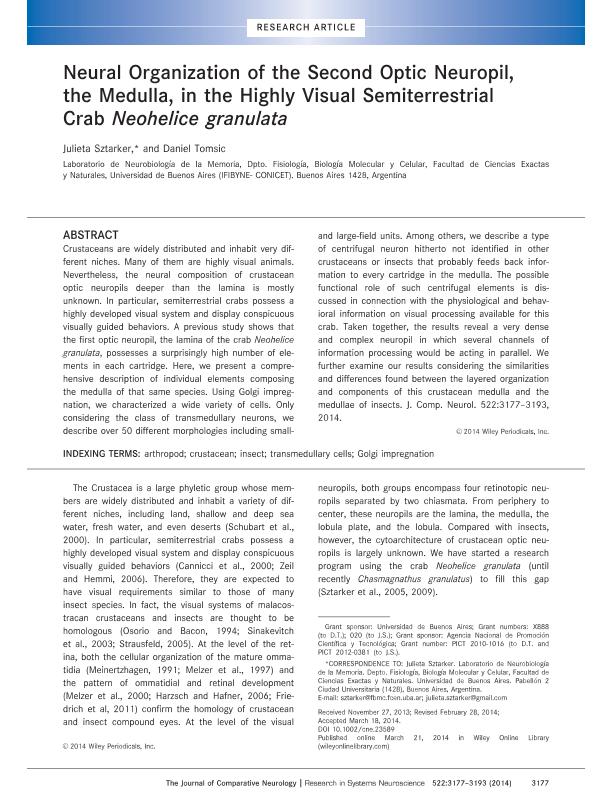Artículo
Neural organization of the second optic neuropil, the medulla, in the highly visual semiterrestrial crab Neohelice granulata
Fecha de publicación:
12/2014
Editorial:
Wiley-liss, Div John Wiley & Sons Inc
Revista:
Journal Of Comparative Neurology
ISSN:
0021-9967
Idioma:
Inglés
Tipo de recurso:
Artículo publicado
Clasificación temática:
Resumen
Crustaceans are widely distributed and inhabit very different niches. Many of them are highly visual animals. Nevertheless, the neural composition of crustacean optic neuropils deeper than the lamina is mostly unknown. In particular, semiterrestrial crabs possess a highly developed visual system and display conspicuous visually guided behaviors. A previous study shows that the first optic neuropil, the lamina of the crab Neohelice granulata, possesses a surprisingly high number of elements in each cartridge. Here, we present a comprehensive description of individual elements composing the medulla of that same species. Using Golgi impregnation, we characterized a wide variety of cells. Only considering the class of transmedullary neurons, we describe over 50 different morphologies including small- and large-field units. Among others, we describe a type of centrifugal neuron hitherto not identified in other crustaceans or insects that probably feeds back information to every cartridge in the medulla. The possible functional role of such centrifugal elements is discussed in connection with the physiological and behavioral information on visual processing available for this crab. Taken together, the results reveal a very dense and complex neuropil in which several channels of information processing would be acting in parallel. We further examine our results considering the similarities and differences found between the layered organization and components of this crustacean medulla and the medullae of insects.
Palabras clave:
ARTHROPOD
,
CRUSTACEAN
,
GOLGI IMPREGNATION
,
INSECT
,
TRANSMEDULLARY CELLS
Archivos asociados
Licencia
Identificadores
Colecciones
Articulos(IFIBYNE)
Articulos de INST.DE FISIOL., BIOL.MOLECULAR Y NEUROCIENCIAS
Articulos de INST.DE FISIOL., BIOL.MOLECULAR Y NEUROCIENCIAS
Citación
Sztarker, Julieta; Tomsic, Daniel; Neural organization of the second optic neuropil, the medulla, in the highly visual semiterrestrial crab Neohelice granulata; Wiley-liss, Div John Wiley & Sons Inc; Journal Of Comparative Neurology; 522; 14; 12-2014; 3177-3193
Compartir
Altmétricas




